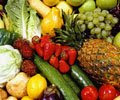| Nearly every food preparation process will reduce the amount of nutrients in food. Processes that expose the food to high heat, light or oxygen will create the greatest nutrient loss in your food. It is always best to keep these processes to a minimum; consuming raw foods is definitely the best way of getting the most out of your food. Below is a general table showing the nutrient loss for common food processing methods. Actual losses will vary with the type of food, cooking time and temperatures. Typical Maximum Nutrient Losses (as compared to raw food) | ||||
| Vitamins | Freeze- | Dry- | Cook+Drain | -Reheat |
| Vitamin A | 5% | 50% | 35% | 10% |
| Retinol Activity Equivalent | 5% | 50% | 35% | 10% |
| Alpha Carotene | 5% | 50% | 35% | 10% |
| Beta Carotene | 5% | 50% | 35% | 10% |
| Beta Cryptoxanthin | 5% | 50% | 35% | 10% |
| Lycopene | 5% | 50% | 35% | 10% |
| Lutein+Zeaxanthin | 5% | 50% | 35% | 10% |
| Vitamin C | 30% | 80% | 75% | 50% |
| Thiamin | 5% | 30% | 70% | 40% |
| Riboflavin | 0% | 10% | 45% | 5% |
| Niacin | 0% | 10% | 55% | 5% |
| Vitamin B6 | 0% | 10% | 65% | 45% |
| Folate | 5% | 50% | 75% | 30% |
| Food Folate | 5% | 50% | 75% | 30% |
| Folic Acid | 5% | 50% | 75% | 30% |
| Vitamin B12 | 0% | 0% | 50% | 45% |
| Calcium | 5% | 0% | 25% | 0% |
| Iron | 0% | 0% | 40% | 0% |
| Magnesium | 0% | 0% | 40% | 0% |
| Phosphorus | 0% | 0% | 35% | 0% |
| Potassium | 10% | 0% | 70% | 0% |
| Sodium | 0% | 0% | 55% | 0% |
| Zinc | 0% | 0% | 25% | 0% |
| Copper | 10% | 0% | 45% | 0% |
Monday, March 31, 2008
Nutrient Loss During Cooking, Freezing, Drying and Reheating
Subscribe to:
Post Comments (Atom)



1 comment:
Eve'ning.
I was poking around tonight to see what I couldn't learn about whether there's a point to soaking flour for pasta if most of it's destined for storage, and I came across your post along the way.
I'm still orienting myself with all the different food-camps out there -- the (Weston A.) Pricers, the Rawvolutionists, the "local folks", the organic zealots, the vegans and vegetarians, the Atkins zealots, the list goes on.
I was interested to know two things about the chart, here.
1 -- whether the chart takes phytic acid and oxalates (and possibly other factors) into account, or whether the vitamins and minerals are measured pre-absorption.
2 -- where you dug up these interesting findings.
Post a Comment